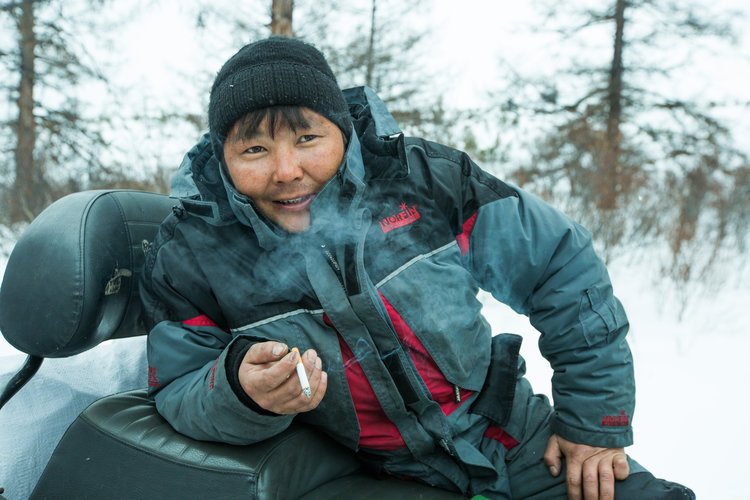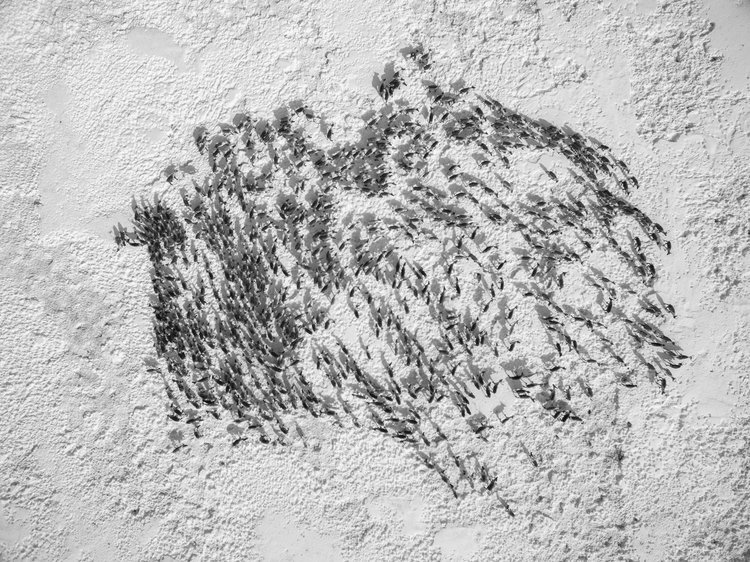Siberia's Reindeer Herders In Pictures
A curious reindeer gets a little too close. Ichinskiy District, Kamchatka, Russia. Photo: Robyn Penn.
If you look at a map of Russia's Kamchatka Peninsula, you will quickly notice it is much closer to Anchorage than Moscow, and perhaps if it were not for the Game of Risk, many people outside of Russia might have never encountered this remote destination.
Kamchatka conjures up images of pristine boreal forests, snow capped volcanoes and abundant wildlife. Outside of the region's only city-- the fly-in capital Petropavlovsk-Kamchatsky-- the population is sparse and spread across a wild expanse of territory.
We flew into Petropavlovsk-Kamchatsky (PK for short) during a lucky break in the March snowstorms and spent our first two days in Kamchatka gathering supplies at the Army supply stores in town before taking a bus north to the quiet town of Esso. Along the way we stopped in the towns of Milkovo, for a Russian canteen-style lunch remnant of Soviet times, and Avangay, before reaching Esso.
A general store in the town of Avangay in central Kamchatka. Photo: Robyn Penn.
A post-sunset view over Petropavlovsk-Kamchatsky, Kamchatka, Russia. Photo: Matt Reichel.
Siblings on the bus between Milkovo and Esso, Kamchatka, Russia. Photo: Robyn Penn.
Soviet remnants on the side of an apartment block in Milkovo, Kamchatka. Photo: Karim Iliya.
Situated on a natural hot spring, Esso made a great starting point for our expedition deep into the wilderness, allowing our team to gather food supplies and bathe in the warm waters before setting out for the frigid backcountry. Esso lies at the heart of central Kamchatka's Bystrinsky District, where ethnic Russians, Koryaks, Itelmens and Evens blend together.
The Even and Koryak people have been traditional reindeer herders in this part of Russia for centuries and despite Stalin's collectivization of their herds in the 1950s, the practice of private reindeer herding is returning to the area. Reindeer herders move with the herd throughout the year, as the reindeer themselves spread across the snow-covered landscape in search of grasses and shrubs to munch on.
We set out on a pack of snowmobiles in search of the heard, located a couple hundred kilometres away. This is a region where the herders use radio signals to communicate with loved ones back in Esso and Avangay. Along with our Russian support team, we packed sleds full of canned food, grains and legumes, gasoline, a couple of generators, snacks, and of course vodka and salo (cured pork fat)-- Russian backcountry favourites.
Children play in Esso's hot spring pool while a dog stays by the side. Photo: Robyn Penn.
Day one on what may be the world's least comfortable seat. Photo: Karim Iliya.
Iliya from the Russian team takes a cigarette break on his snowmobile. Photo: Karim Iliya.
A quick break in the backcountry. Photo: Karim Iliya.
On the first day in the backcountry, we quickly learned just how cold it can get riding for hours across snowy valleys and boreal forests. As we didn't have enough snowmobiles for everyone to drive, we had to alternate between driving, riding and sitting in what we dubbed the "chariot." The "chariot" consisted of the back seat of an old car screwed onto a wooden sled frame and pulled behind a snowmobile with a chain. Needless to say, it was one of the least desirable seats in the pack.
After coming close to second degree frostbite on the first day, we camped out at a local Even man's cabin in the wilderness. Having lived along there since the 1980s, Viktor was a welcoming host and we spent the evening sharing our food and drink in exchange for shelter and good company.
The next day we were far more prepared for the expedition, wearing significantly more clothing and waterproof jackets this time around. We continued into the vast wilderness, stopping at a hunting cabin for our second night before continuing on the next morning in search of the reindeer herd.
For the love of dogs. Photo: Karim Iliya.
A piece of salo on the cutting board. Photo: Robyn Penn.
Viktor and his cat. Photo: Robyn Penn.
Viktor sitting in his home. Photo: Matt Reichel.
On the morning of the third day in the backcountry we finally received a radio signal from the herders with their location in reach. The herders were relatives of Ilya, one of our Russian team members and were awaiting his arrival to bring them a fresh set of food supplies.
We met the herders at their winter yurt before setting off with them to find the herd. The yurt was well insulated and the herders had the stove burning strong when we entered. They offered us a lunch of reindeer meat stew from one of the herd they culled a couple days before.
The floor of the yurt was covered in small branches and twigs and then reindeer pelts are layered on top of them, providing a double layer of insulation from the cold ground. We sat on the pelts and slowly slurped away on the stew-- it was delicious and it felt great being truly warm. We then followed one of the herders for about six kilometres more on the snowmobiles to reach the 600-head strong reindeer herd.
Reindeer bask in the last remaining sun rays before sunset. Ichinsky District, Kamchatka, Russia. Photo: Matt Reichel.
An aerial view directly above the reindeer herd. Photo: Karim Iliya.
A snowmobile slowly approaches a herd of reindeer. Photo: Karim Iliya.
After spending the entire afternoon with the reindeer, slowly building trust to be able to approach them, we took the snowmobiles back to the yurt just after sunset. It was getting much colder out as the sun rays disappeared behind the snowy peaks.
We spent the night bunkered down in the yurt with the herders, where we enjoyed a hot meal of reindeer stew with grechka and onions. The temperature inside was incredibly warm and the thick reindeer pelts over the twigs provided a comfortable layer to sleep on. That night we passed around a couple bottles of vodka with the herders, exchanging stories.
Meal time conversations and relaxation inside the yurt. Ichinsky District, Kamchatka, Russia. Photo: Robyn Penn.
An aerial video of the Kamchatka boreal forest and river. Photo: Karim Iliya.
One of the reindeer herders refills the water kettle outside the yurt. Photo: Matt Reichel.
Our expedition team taking a break before conquering the next mountain pass. Photo: Karim Iliya.
After spending a couple of days staying with the reindeer herders, we slowly made our way back to Esso, cutting through the remote Kamchatka wilderness on our snowmobiles. The chance to truly experience such vast and untouched wilderness, and spend time with reindeer herders continuing centuries of tradition was nothing short of remarkable. I'll let the photos speak for themselves.




















